Note: the photograph turned out to be real after all. See here.
In a comment to an earlier post, Alan pointed out that it has been claimed that the photo I used was a propaganda fake. As I have previously discussed the subject of fake combat photos, I was appropriately mortified at the thought of having been taken in myself! So let's have a closer look at it ...
Here it is again:
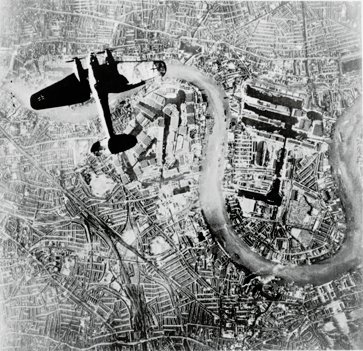
It's an extremely well-known image. In fact, it seems that it requires a certain strength of will for editors to not use it: both histories of the Battle of Britain I have to hand feature it, as does one about the Blitz.1 If I flipped through all my other books, I'm sure I could find a few more.
It's easy to see why it's so popular. It's a very striking composition, with the black shape of the bomber menacing the defenceless streets below. Maybe the fact that it is so striking is a reason to be suspicious? After all, a propaganda image is chosen (or manufactured) for the impact it will have on the viewer. And the ground is very clear, isn't it -- so shouldn't the Heinkel be more out of focus? Maybe, but that would depend on its height as well as that of the aircraft taking the picture, as well as the details of the camera used. The shadows might be another clue. The photo was supposedly taken in the evening (1848 hours, German time, to be precise), so the shadows should be long and away from the Sun in the west (up is north, here). They are for the Heinkel (taking into account the upward sweep of its wings), but it's hard to make out any shadows on the ground. Maybe the structures are very flat -- London was not a very high-rise city -- but I do find that a bit suspicious. This blown-up version from the site making the charge doesn't seem to show any either. (Click for the full-size version.)
What does that site actually claim? It's about the history of Millwall Football Club, of all things. But the evidence presented by Gazza is potentially persuasive. The connection to Millwall FC is that their former home ground, the Den, is visible in the photo, and that there is no cover over the north terrace. As this cover was built in 1938, the conclusion is that such a picture could not possibly have been taken on 7 September 1940, as claimed. (Incidentally, 66 years ago yesterday.) This sounds like a good use of local knowledge ... but is it true?
The red circle marks the location of the old Den. I've blown this area up by 700% -- it's highly pixellated, but bear with me.

And here's another aerial shot of the Den, this time taken in 1962. (Taken from here and rotated and cropped -- hence the white areas in the corners -- so as to roughly match the previous image.)
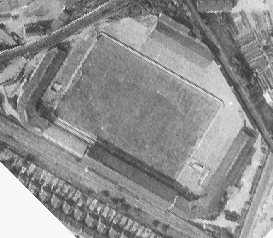
Now, pixellated as the first image is, you can clearly see the roofs over the south, east and west terraces, but not one over the north terrace. Comparing this with the 1962 image, the north terrace one ought to be visible too. So, it
is looking like the photo is a fake. Gazza may be right!
However, a couple of questions remain. Why would the Germans go to the effort of faking this picture? After all, they had plenty of bombers flying over London, with bombardiers peering downwards and occasionally even journalists with cameras. Such photographs would have been taken after raids to determine the extent of the damage inflicted -- whether they were taken during raids, I'm not sure. There's nothing inherently implausible in the idea of such a picture being taken, though (unlike the First World War dogfight ones). Was it to avoid giving away details of the capabilities of the German photoreconnaissance cameras? I seem to recall a Biggles story revolving around the capture of a fancy new German camera, but I don't know if anyone cared about this in the Second World War.
The other question concerns provenance. I don't know where this picture first appeared. It's normally taken from the Imperial War Museum's collections (C 5422), but presumably they got it from a German source (unless it's a British fake!) The IWM clearly doesn't think it's a fake, judging from their description:
A Heinkel He III [sic] bomber flying over Wapping and the Isle of Dogs in the East End of London at at the start of the Luftwaffe's evening raids of 7 September.
But it doesn't actually say where the IWM got it from, so I still don't know if it was actually used as for propaganda purposes.
The only clue I have as to a German source comes from Winston G. Ramsey, The Blitz Then and Now, Volume 2 (London: Battle of Britain Prints International, 1988). This is an extremely thorough, day by day chronicle of the Blitz. The Heinkel photograph is on page 56, and the caption clearly states that this version comes from Bundesarchiv in Germany, not the IWM, though it doesn't specify the precise source. It's a bit unclear, but the caption also seems to suggest that a set of photographs on page 50 -- this time sourced from the US National Archives -- were taken by the same He 111 that is in this photo. There's even one taken at about the same time! And here it is:
It obviously covers a much wider area than the other photograph. The huge plumes of smoke rising from the Royal Docks dominate the view; dramatic evidence of the beginning of the Blitz. But speaking of smoke ... I've cropped and expanded this new picture to roughly match the original one.
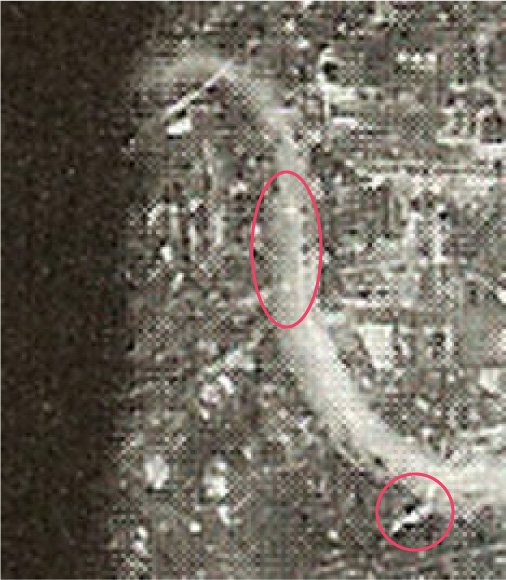
The feature circled looks like a plume of smoke. And there's something very similar in the first picture, in about the same place; here's a zoom of it:
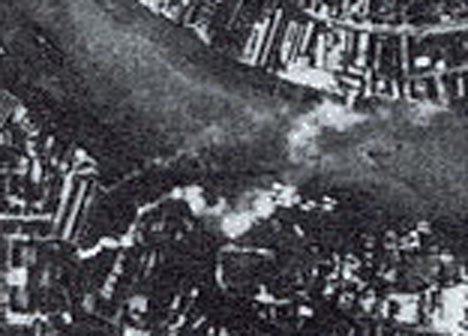
So -- if the smoke appears in both images, does that mean its genuine after all? I think so, though there is a chance that there was a factory or something there which was always pumping out smoke. The colour or shading of the smoke seems to change, but smoke can do that. The clincher for me is the two white dots on the Thames (inside the ellipse). I think these are the boats that can be seen in nearly the same place in the original photo.
I've changed my mind about 5 times in the course of writing this post. My tentative conclusion at the moment is that the photo in question is genuine, but I admit the missing north terrace roof at the Den is troubling.
What a long, strange trip it's been. Well, a long one, anyway.
![]() This work is licensed under a Creative Commons Attribution-NonCommercial-NoDerivatives 4.0 International License.
Permissions beyond the scope of this license may be available at http://airminded.org/copyright/.
This work is licensed under a Creative Commons Attribution-NonCommercial-NoDerivatives 4.0 International License.
Permissions beyond the scope of this license may be available at http://airminded.org/copyright/.
- I certainly lack that strength -- I originally put the post up without a picture, then quickly decided it needed one after all, and as I was in a hurry I immediately thought of 'that one with the Heinkel flying over London'! [↩]

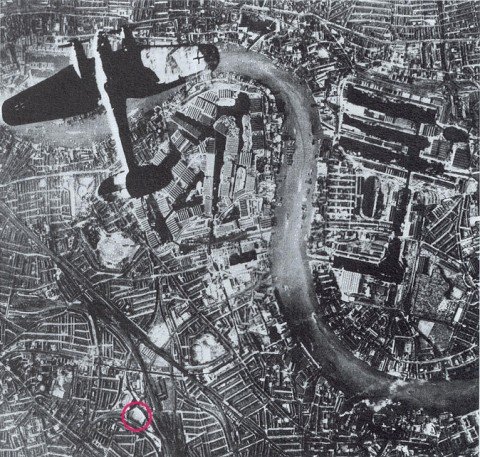
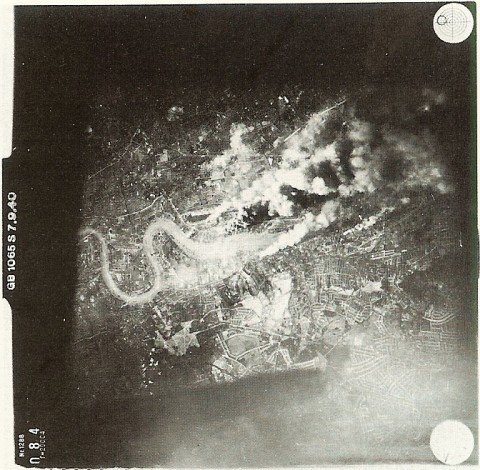




Alan Allport
Hmm. As I understood it the first bombs of the Blitz on 9/7/40 landed on the old Surrey Docks in Rotherhithe (there is a plaque on the wall of the police station near Surrey Quays tube stop commemorating the event), which seem undamaged in the second photo you provide.
Brett Holman
Post authorI think you're right! The Surrey Docks were hit during the daylight raid, and masses of pine wharfside went up in flames. There should be smoke coming from that area, and in the blow-up of the photorecon pic, it does look like there are two or three smoke plumes there. So now I'm swinging back to thinking it's fake!
Alex
In fact, on the original, Rotherhithe looks entirely untouched (it's the dock complex on the west side of the Thames opposite the West India docks on the Isle of Dogs). The 7th September raid caused the world's first firestorm among the warehouses there, a cutdown version of what the RAF would do to Hamburg three years later.
It is of course possible that the photo is genuine but misdated, or perhaps taken before the main attack. ISTR the big (200+) raid on the 7th began late in the day, I think about 1740 UK time, although there had been more action earlier on. It's possible that if the photo is real, it was taken during a smaller raid earlier on the 7th.
As far as Mi'wa' goes (sorry - phonetic spelling!), the error-bars on that look gigantic to me. Remember that the sun sets in the West. In early September it would be fairly low in the sky, and would set not long after 2000. Clearly the other terraces would be easily visible by their shadows on the pitch, and indeed, both on the original image and your enlargement, the west and south terraces cast a clear shadow. The ground is aligned WNW-ESE, so the south terrace would show a small shadow, but the north terrace's shadow would overlay a dark area on the photo and therefore wouldn't be visible.
For my money it's genuine.
Brett Holman
Post authorArgh ... I think you're right on the first point, Alex. I couldn't find a precise time for when the Surrey Docks were hit -- it was definitely in the late afternoon, though. Juliet Gardiner's Wartime says the raid alarm was sounded at 1643, and the all clear shortly after 1800. Even though I took care to note in the post that the 1838 time was German time, I then assumed it was local time and so the docks should have been ablaze. But of course, 1838 in Germany is 1738 in the UK, so there the photo could have been taken just before the raid on the docks. And that fits with the 1740 time you mention. So I'm back to thinking it's probably genuine. (BTW, if it is genuine, it must have been taken late afternoon, not earlier in the day, due to the shadows on the Heinkel.)
However, I stand by my comments on the Den. Yes, the shadows are clearly visible, but you can also see the terrace covers themselves, particularly the sourthern one: it's 2-3 pixels wide and significantly lighter than the shadows, but darker than the adjoining railway. The area where the roof over the northern terrace should be is very bright -- there's nothing there to suggest a long dark object is present.
Playing with the 1962 image shows what we should see in the putative 1940 image, if the north terrace cover was there. The shadows are very short so aren't a factor. I've squashed it so it's about the same number of pixels as in the crop from the 1940 image:
All the terrace structures are clearly distinguishable -- the north and east ones less so than the others, admittedly, but they are still there. So there's enough resolution in the image in question that the northern one should be visible -- it definitely break up and truncate that big white area in the corner.
Maybe Gazza's wrong about the cover being built in 1938, or maybe it was taken down/under repair in 1940, or the roof painted white or something. My tentative conclusion is (once more) that the photo is real -- I can't really see why it would need to be faked, and there's no evidence as yet that it was in fact used for propaganda -- but I don't like going up against a hard-core football tragic on the history of his club! :)
Alan Allport
As you say yourself, "it’s a very striking composition, with the black shape of the bomber menacing the defenceless streets below." If I was one of Goebbel's hacks it's precisely the kind of picture I'd doctor.
Brett Holman
Post authorWhy does WordPress keep putting in three backslashes before single and double quote marks? Only seems to happen when I edit a comment after I've posted it. Stuffed up the image I posted, too.
I agree it's striking, but why not just use one of the actual shots of London burning (as seen above) instead of a peaceful pre-1938 one? I would think that more effective for propaganda purposes. After all, by this stage we are past threats of bombing and into actual apocalypse, at least as far as the Docklands are concerned. Of course, I'm assuming it's a post-Blitz photo, maybe it was faked before London was ever bombed -- maybe before the war even started. Without provenance, it's hard to be sure of anything. But The Blitz: Then and Now claimed they got it direct from the German national archives. It would be surprising if there wasn't some indication there that it was fake -- like being in the Propaganda Ministry files and not the Luftwaffe's :)
Brett Holman
Post authorAh, the blackslash mystery is cleared up: when I edit a comment, it puts in a blackslash before the quote marks, presumably to escape them. Then if I edit it again, it escapes the quote mark, even though it's already escaped -- and then escapes the backslash inserted during the previous edit! Silly WordPress.
Alan Allport
When Sony's fake movie reviewer David Manning was unmasked it was pointed out that the subterfuge was, in principle, unnecessary: there were plenty of unprincipled journos willing to write whatever their patrons told them so long as the checks kept coming in. But perhaps it was just simpler and neater to make someone up. In the same way, perhaps it was just easier for the Nazi propaganda people to do a little cutting and pasting to produce the perfect shot, even if they could with a bit more effort have found an authentic picture.
Brett Holman
Post authorOh yes, I'm sure that's true. What I meant, but did not say very clearly, is that that I would have thought that montaging a bomber over a backdrop of London burning would be a more effective piece of propaganda than one with an undamaged London. But it's all just speculation, as we don't even know when and where the picture first surfaced.
Gazza
Brett Holman "Maybe Gazza’s wrong about the cover being built in 1938, or maybe it was taken down/under repair in 1940, or the roof painted white or something."
The above picture shows the North Terrace on 6th March 1937 and on 1st october 1938
The second picture shows the Den after being hit by a bomb in March 1943.
One thing often over looked is that this bomber is coming towards the Zielraum G from the wrong direction for September 7th 1940?
All the accounts of the day are the first attackers came up the Thames Estuary, so what is our friend doing flying north? Did he come all that way and not bother to drop any bombs? And why is one plane a lot higher than another in a bombing formation over the target area? Not a safe place for the lower bomber!
"It had been an easy flight up from the Thames Estuary and along the Thames. There was no opposition and we felt that we had the whole sky to ourselves, we were at 5.000 feet. The docks at Woolwich stood out almost as if beckoning for us to release our bombload. Through the glass canopy I could see tall cranes and the long square shape of the three main docks, I lined them up carefully, and as I pressed the release button I looked elsewhere at the huge mass of buildings and warehouses below then just caught a glimpse of the sticks of bombs as they kinked from side to side as they fell towards earth. " Helmut Staal, of the leading fight of bombers of II KG/76
"We got the red alert as was often the case when an impending raid was approaching from the Thames Estuary. But the usual practice was for the bomber formations to split up near the Isle of Sheppy and they then set course for the RAF aerodromes north and south of the Thames the we would revert back to a yellow. But in this case we was under a 'red' for longer than usual and messages started to come in that the bombers were seen coming up the Thames. Well, I went up and I have never seen anything like it. A thick blanket of black bombers which must have been two miles wide following the Thames.
Our station was almost at the road junction that now goes down to the Woolwich ferry and we had an excellent view of what was going to happen. I think the first bombs were dropped just before the dock areas and the right side of the formation would pass right over us. We could do nothing but get back to our posts and pray like mad. The sound was deafening, the building shook and dust from walls and ceilings started to envelope our desks, we could do nothing while the raid was on although a few phone calls came through, 'this street got it' and 'so and so building has got a direct hit. Then silence, slowly the phones died, lines had been cut and we knew that once it was all over we would have to rely on messengers. "
William 'Bill' Thompson Civil Defence Woolwich
I'm sure someone can do the maths on this calculate the height of the aircraft in the picture....
HE 111
Length: 16.4 m (54 ft 6 in)
Wingspan: 22.5 m (74 ft 3 in)
A fixed distance across the Isle of Dogs, taking the centre of the South Dock of West India Docks is 0.84 miles.
The source of the smoke is deptford power station, the above picture is from 1925.
Gazza
Oh dear the Pics looked Ok in the preview pane but have not appeared in the post!
Here are the links.
The North Terrace at the Den 1937 and 1938
http://www.millwall-history.co.uk/Millwall%20North%20Terrace%201937%20and%201938.jpg
The Den 1943
http://www.millwall-history.co.uk/Bombed.gif
Deptford Power Station
http://www.portcities.org.uk/london/upload/img_400/H2566.jpg
Pingback:
Airminded · Gazza speaks!
Gazza
And this higher resolution blow up of the den may help
http://www.millwall-history.co.uk/The%20Den1940.jpg
Brett Holman
Post authorThanks for dropping by, Gazza. I hope you didn't mind my not just taking your word for it! For what it's worth, I've been swinging around to the "fake" point of view since the discussion here. Just too many inconsistencies, and I really don't think there is a north terrace there in the supposed 1940 pic. Now you tell me that the smoke plume I pointed to is actually a power station and not smoke from a stray bomb, and that strengthens the conclusion. And I don't think I should put much stress on a couple of white dots in the middle of the Thames.
(You're probably right about the direction of flight of the He 111, but I don't find that conclusive by itself -- it could be flying in an odd direction for any number of reasons. But anyway, the conclusion doesn't rest upon that argument alone.)
So, good call, and well spotted! Have you tried getting in touch with the Imperial War Museum to tell them that they have captioned that picture (C 5422) incorrectly -- or if they think they haven't, can they give us chapter and verse on the origins of the photo? In fact, even if it is a fake, I'd be curious as to the history of the picture and how it ended up becoming one of the best-known images of the Battle of Britain?
Gazza
Don't mind at all being challenged to back up a statement.
I haven't contacted the IWM, might be worth sending them an e-mail.
The issue was raised in the Guardian in August 2006....Corrections and clarifications
http://www.guardian.co.uk/corrections/story/0,,1855309,00.html
Joe Pitcher
The smoke in the bottom two pictures is almost certainly coming from Deptford power station, which still stands but has not been operational since the early eighties.
Joe Pitcher
New Cross
Brett Holman
Post authorThanks, Joe, you're right. A bit of local knowledge helps!
Pingback:
Airminded · Return to Millwall
Pingback:
South East London during the Blitz - World War 2 Talk
Pingback:
Best Bomber Picture of WW2... - Page 2 - World War 2 Talk
Andrew Rennie
Hello,
I am working on a book on Australian pilot killed during the Battle of Britain, Flt Lt Richard Carew Reynell. Richard was killed on the 7th of September 1940 he and his Hurricane (V7257) fell to earth at Blackheath, Richard has exited the aircraft but his parachute failed to open. In the photogrametry photo from the 7th of September shown above Blackheath can be seen. I was wondering where this photo was obtained from and if it is available in a higher clarity? Dependant on the time the photogrametry picture was taken I may be able to pick out the smoke or wrekage of Dick Reynells aircraft on the Point at Blackheath.
Regards
Andrew Rennie
Brett Holman
Post authorProbably best to contact the Imperial War Museum Collections; they hold a copy of the photo as image number C5422. The US National Archives may have a copy, the same goes for the German Bundesarchiv, but I wouldn't know how to find it.
Gazza
As a follow up 4 years on, a couple of 1945 - 1947 bomb damage survey photographs have come to my notice.
http://www.millwall-history.co.uk/The%20Den1945Small.gif
http://www.millwall-history.co.uk/The%20Den1947Small.gif
Also Google Earth now have 1945 coverage of London, which allows you to replicate the height of the German photo which does seem to be around 5,000 metres, which would be far too high!
Another German photo from 7th September 1940 seems more genuine was shot over the Victoria Dock/West Ham Stadium
http://www.monkhardy.co.uk/wp-content/uploads/2010/01/royaldocks080940aX.jpg
Brett Holman
Post authorThanks for the update, Gazza! I don't think 5000 metres would be too high, if anything it's a bit low -- it's 14400 feet and the operational orders for the 7 September raid had the bombers coming in at between 15000 and 20000 feet. This would have been taken by a recon flight though, not sure what its height would have been. From the reference in The Blitz: Then and Now, the film from the flight still exists, possibly in the US National Archives, and it looks like whoever wrote it up (it's a multi-author work) had seen it as they give individual frame numbers. That would seem to be the best place to look...
Gazza
An interesting Thread on the Photo on here
Ubisoft forum
When they match up the Isle of Dogs photo and the West Ham photo it reinforces my feeling the Isle of Dogs photo is a fake
Combined overlay on London Map
Brett Holman
Post authorIt's nicely done but I don't see how it really adds anything one way or the other. What we really need now is documentary evidence to shed light on the provenance of this photo, most likely from the IWM, the Bundesarchiv, TNA or NARA.
Chris Going
Interesting article and follow-up posts. I have been trying to piece together the history of this iconic photograph and am almost there. It's possible Millwall football ground was photographed by the Luftwaffe on June 4th or 8th 1939, the evening of September 6th 1940, around midday on September 7th 1940, twice on the evening of September 7th 1940, and on the 27th September 1940. I have seen prints from some of these sorties. I'll try to get hold of extracts showing Millwall football ground and then we can see why the roof is so hard to see.
Brett Holman
Post authorThat sounds very promising, Chris! Where will you publish your findings?
Also: 4/8 June 1939 -- so the Luftwaffe did a pre-war reconnaissance flight over London? Is that right??
Chris Going
The Luftwaffe, in the shape of Rowell's ObdL clandestine reconnaissance outfit, took imagery of London, Coventry, and Birmingham in May and June 1939 (and Paris as well, on June 4th I think). Not many prints survive from these sorties, and the original films were destroyed long ago.
The photographer who took the image of the He 111 over Millwall was from KG 1. The rest of the photo sequence shows HE strikes and explosions in Poplar. Incidentally, the annotated reconnaissance image you reproduce was taken just a few seconds after the He 111 image. You have ringed white mark(s) in the Thames. These are plumes of water from bomb strikes in the river.
I was thinking of offering the article in the first instance to Prologue, NARA's in-house magazine (they have the original Heinkel snap from which the IWM print was copied), or to a House mag for veteran image analysts. I'll keep you posted.
Brett Holman
Post authorSo if the photo has a documented context and is from a series of similar images taken at the same time, I think it is (finally!) safe to conclude that it is, in fact, genuine after all, irrespective of the roof colour at the Old Den. As I've been saying, somebody had to go into the archives to resolve this question (though I was thinking the IWM rather than NARA, since everyone seems to source it from there), and that's what you've done. +1 for archival research!
Interesting about the pre-war reconnaissance flights; I didn't know about them. There's a page about Aufklärungsgruppe Ob.d.L. here; it doesn't seem to mention British overflights but this mentions a reconnaissance flight over Yate on 26 August 1939.
On the spots I circled in the Thames: looking at it again, one does look like a plume but the other doesn't, and the corresponding point on the 'iconic' photo seems to have a wake trailing from it (though maybe it's a channel or the boat was very fast as it's quite a long wake).
I look forward to reading your article. Have you thought about pitching it to a popular history magazine like History Today or BBC History Magazine? It is so very iconic (I've written about that before, here) that they might be interested in a piece about it.
Chris Going
The real breakthrough was being able to look at the back of a wartime German copy of the Heinkel photo (not the NARA image or the IWM copy image) and get the print number, film identification, and date off it. This and a fortuituous camera fault (the shutter jam on the right hand side of the image) tied it into a sequence of about twelve other images in a private collection which I had long suspected, but could not prove, came from the same sequence. Needless to say the all important frame 074 -our Heinkel- was lacking.
The bomb strikes are at the top (N) end of your oval gloss: the remainder are smoke plumes, as you note.
Certainly could offer it to History Today or some such but I don't want it subbed to heck and I have a weakness for lengthy footnotes...
Chris Going
Minor emendations to last night's posts -then a bit tired- Rowell is how Rowehl's name is pronounced, not spelled. Also our magic frame is 075, not 074. That'll teach me to look up my notes before banging stuff off. If the GAF had published this image internally -say for damage asessment purposes, it would have been cited as "Bild: Stabia Lfl. 2 F922/40/075" Had the a/c carried more cameras we would have got the designator -eg SG, SK, or SD.
I'd better get all this in the public domain pronto.
JDK
Fascinating stuff, Chris, I look forward to reading the full story!
(And at the risk of stating the obvious, these shots clearly aren't from the ~ pre-war ~ 1939 sorties, though those clandestine reconnaissances are also very interesting.)
Pingback:
Millwall’s end
Brett Holman
Post authorJDK:
Yes, nothing to do with 'the' photo, I just was curious to know more about the prewar overflights!
Chris Going
During the last five months of peace -in fact during the whole of the period for which daylight and shadow lengths are today judged suitable for aerial survey- the Germans made flights over UK airspace with reconnaissance cameras. The earliest I know of is a sortie of April 12th, which imaged Newhaven (Sortie 432). By August 31st 1939 the Sortie list had crept up to 586 (Blyth). In between, overflights were made of Rochester, Woolwich, and Greater London (Sorties 446 of May 24th 1939 and 467 of June 4th); Coventry and Birmingham (Sortie 458; June 8th 1939) , Blyth (August 31st 1939). Millwall fans will be glad to know the Den roof is clearly visible on May 24th 1939.
We have a minimum, then, of 154 photographic flights flown in the five month period leading up to hostilities. While these will include overflights of France and the Low Countries (the 4th June Paris cover I alluded to elsewhere has a sortie number from the same sequence) that's one a day and given the problems cloud cover causes when one is trying to do air survey Rowehl's lot were pretty busy.
I've been making notes on this stuff towards the inevitable book for years. I guess I'd better crack on with it.
Brett Holman
Post authorOh yes… no time like the present!
These prewar reconnaissance flights remind me of the Graf Zeppelin II's espionage flights off the east coast in 1939 which attempted to eavesdrop on the experimental radar station at Bawdsey -- of course this was ELINT, not photoreconnaissace. There seem to be conflicting reports on how many flights and when, but it seems like two or three with a short or abortive one in May and the last one taking place between 2 and 4 August 1939.
JDK
The Graf Zeppelin's ELINT flights were covered in some detail in an Aeroplane magazine's Secret History article a couple of years ago. If anyone's interested, I can look that out. They were, I recall, failures as they scanned the wrong frequencies.
I also have a vague recollection that Lufthansa were suspected of photographing places like Croydon airport while flying in and out just before the war; I'm assuming that was with handheld cameras for various forms of oblique photography. Leading from that, I wonder if the pre-war flights Chris is talking about were clandestine under Lufthansa colours or potentially diplomatically fraught Luftwaffe ones. In either case, one assumes they were fixed vertical mapping style cameras.
Of course 'we' were doing the same going the other way with the now-famous Lockheeds of Sidney Cotton - private aircraft with (unusually) hidden, fixed mapping type cameras.
Brett Holman
Post authorFrom the brief mention here it sounds like they had Lufthansa markings.
One reason I find these overflights interesting is the parallel with the pre-1914 phantom airship scares, or rather the lack of one. What happened here is pretty much what the Germans were believed to be doing with Zeppelins in 1909 and 1913, flying around and spying on Britain. Why did people think they saw German aerial spies in 1909/1913 when there were none, and then, in 1939 when there were real ones, not (as far as I know) see any at all? To put it another way, why weren't there any large-scale mystery aircraft scares in Britain after WWI? It must have something to do with the fact that aviation was no longer as novel and unfamiliar by 1939. But that's not wholly satisfactory, given the mid-1930s ghost flyer scare in Scandinavia. More thought required...
Pingback:
Not Millwall
Pingback:
?????? ? ????? #69 : ???????????????????????
Zaelon 1
I am not sure that this photo comparison is valid.
To ensure it one way or the other you would need to either know the time of the photo or be able to calculate it from shadows etc in the photo.
Then you would need to simulate the direction of sunlight to create another picture this could then be "pixelated" to compare to the original.
Totally beyond my abilities, anyone know a boffin?
Brett Holman
Post authorYou're right that the comparison is not conclusive; it was only meant to be suggestive. (I did discuss the time the photograph was taken in the post, 1848 hours German time, which would need to be corrected to GMT and possibly take summer time into account?) But in any case the question is moot because the matter has been resolved via a different route. Short answer, the photograph is real after all. Longer answer, see here. I'll put a note to this effect in the post itself, while I think of it.